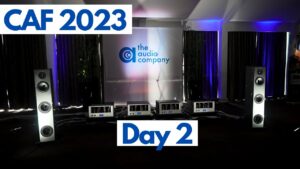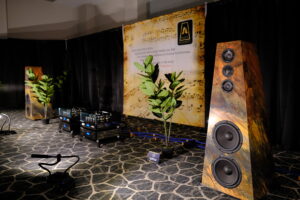
Perhaps it’s no surprise, given that Munich is smack dab in the middle of car country, that the city’s audio show also included a miniature auto show. Of course, this particular auto event was open only to select vehicles: those graced with genuine high end audio systems. Three such examples were on display in the MOC’s grand atrium: a Porsche Cayenne SUV replete with a Burmester audio system; the Cayenne’s slightly down market sibling, the VW Toureg, outfitted with a system devised by Dynaudio; and the flashy, $1.3 million Pagani Huayra sports car, whose sexy flanks had somehow been coerced by Sonus Faber to accommodate a sound system.
As has become common in such pairings—including the now familiar team-ups between Lexus and Mark Levinson, Audi and Bang and Olufsen, and Jaguar and B&W—the auto and audio manufacturer in these examples worked closely together right from the design stage. The cooperation is bi-directional; the sound system is designed specifically for the spaces it will occupy, and those spaces may be modified to better accommodate the sound system. This means that a high end OEM auto sound rig has advantages that aftermarket systems cannot hope to match. It also means that the high end suppliers know exactly what they’re getting in terms of a dreadful sonic environment—and can compensate with unusual precision.
That compensation invariably takes the form of DSP, which not only performs equalization but road noise cancellation and speed-related volume adjustment as well. Another frequently wielded tool is Class D amplification. A typical high end car audio system boasts at least a dozen strategically-placed speakers—the better to create encompassing sound for every passenger. In addition, the larger drivers are asked to generate unnaturally low frequencies from unusually small spaces. All that calls for a lot of watts. Indeed, many of these systems must generate over a 1,000 watts! Heavy, large class A/B amps just aren’t going to cut it. For car audio, nothing beats Class D’s combination of low weight, minimal heat, and high output.
Lest you be concerned that our cherished high end brands will lose their handcrafted focus on immobile audio systems, fear not. Most of these companies lack the capacity (or the insanity) to undertake manufacturing chores for thousands of vehicular sound systems. Instead, in cooperation with the auto maker, they design and extensively test their systems. The final result is, in essence, a specification, which gets parceled out to a builder and supplier familiar with the many special requirements of automobiles.
As in all things high end, car sound systems may have myriad design and construction commonalities, but they still end up sounding radically different. So I set out to test and rank the relative mettle of the three Munich exhibitors. With the doors and windows shut tight to block out the hall cacophony, and my own material streaming from either a CD or a USB stick, the only thing missing was a winding road. Here, in ascending order, is what I heard.
3: Sonus Faber/Pagani
No question about it, Sonus Faber had the toughest challenge of these three vehicles. A gull-winged sports car with the engine right behind the driver’s head is bound to be even less accommodating to a sound system—heck, it’s not even very hospitable to humans—than run of the mill cars. Further, to keep weight to an absolute minimum, Pagani dictated that SF had to bring in the entire system at less than 22 pounds. That meant using not only Class D amps but carbon fiber drivers.
On the other hand, Sonus Faber did have a few advantages. One of the eternal challenges with car audio design is imaging. How do you optimize it for the driver and the passenger, and for both front and back seat occupants? In a two seater like the Pagani, these problems are at least partially simplified. Further, unlike any vehicle with multiple seating rows, the Pagani offers a space behind the two seats and in front of the engine fire wall that’s just big enough to shoehorn a couple of coaxes and a subwoofer. Between these and the typical dash and door mounted drivers, the Sonus Faber system can deliver true surround sound.

Before I could listen to anything in the Pagani, I first had to gain entry, a task that is not so easily accomplished. You don’t step up or slide into this car’s carved buckets; rather, you hover precariously, holding onto a convenient hand grip for safety, swing your derriere inward while simultaneously releasing the grip, and hope you drop into the seat and not onto, say, the hand brake. Once inside, you realize that getting out is going to be even more arduous, so you might as well get comfortable. Still, you must reach up—way up—to grasp the gull-wing door. Pulling it closed requires the kind of strength I imagine truck drivers need for the doors on their big rigs. If you fail to pull hard enough, you must start the process over. Success is rewarded, though, with an uncommonly tight seal.
Like all three of these systems, a touch screen controls the various source and setup functions. In general, I found all these screens very intuitive (once I switched the language to English). The presence of DSP enables a plethora of acoustic “ambiences”: Jazz Hall, Concert Hall, etc. To me, the sound of these options vividly illustrates the maxim that just because you can do something doesn’t mean you should. For my listening, I always chose the least processed, most linear setting.
The Sonus Faber system offers two source options: a USB slot under the center arm rest and a CD player waaay over in the glove box. As if this wasn’t inconvenient enough, fumbling around blindly in there still doesn’t yield a CD player. That’s because the unit is recessed into the compartment’s roof. You have to find and press a hidden button to get the player to motor down. I guess when you spend this kind of coin on what is essentially a street-legal race car, you know going in that convenience is by the wayside.
So how did this brew of constraints and opportunities ultimately gel? Sadly, not well at all. As I mentioned, I started every system set to flat. In the Pagani, the result managed to sound both bright and muddy. (A Sonus Faber rep later confided to me that Pagani wanted it that way.) Deft use of the tone controls—but not those awful “ambiences”—tamed a goodly chunk of these issues. I could get reasonably close to tonal neutrality. Nonetheless, nothing approaching coherence was ever within earshot; I could always hear individual drivers. Nor was decent imaging ever evident, despite the favorable layout. Finally, my Stravinsky dynamics test became moot when the speakers, upon being moderately cranked up, began to bottom mercilessly.
Ultimately, Sonus Faber was dealt an inherently difficult hand with the Pagani Huayra. I’m sure the company did the best that could be done, given the limitations imposed by the car and its manufacturer. Had the car been in motion, I’m sure other sonic impositions—like a V-12 roaring right behind your ears—would have cropped up. Probably best, then, to just forget about the sound system and listen instead to that AMG-derived, 720 horsepower motor, which is surely the sweetest music this car makes.
2: Burmester/Porsche
Not surprisingly, given its pedigree and the nature of the host vehicle, the Burmester system felt the most luxurious of these three. Beautifully integrated into the car’s interior, it exudes quality in exactly the same way as do Burmester’s home audio systems. I can pay it an even higher compliment: it sounds like a home audio system. Good enough, in fact, to be judged according to our standard home system criteria.
Imaging, for example, is excellent—very nearly as good as in a high end home system. Clarity and high end extension are also exemplary; courtesy, no doubt, of the ribbon tweeters. On this system, when Michael Wolff plays the highest piano notes (on his 2am CD), the overtones veritably sparkle, just as they should. The same album features sturdy bass, which gave the Burmester system’s 300-watt active subwoofer a chance to strut its stuff. It had the Cayenne literally shaking. I have never heard bass this low in a vehicle. Finally, from a practical standpoint the Burmester took top honors with its center console, slot-mounted CD player.

The Burmester rates number 2 here not because it has any major failings, but because there was one system that was slightly better. If I were buying a Porsche, I wouldn’t think twice about ticking this option box, even if it meant forgoing crested wheel lugs. Any auto sound system that can convince you you’re listening to a high end home system earns the highest recommendation.
1: Dynaudio/VW
The Dynaudio system is simpler than the Burmester. It features “only” twelve drivers (the Burmester has sixteen) and “only” 650 watts (the Burmester has over 1,000). Yet, as we all know, in high end audio simplicity can be a virtue. So can sweating the details and, as one would expect from a speaker company, Dynaudio lavished particular attention on this system’s drivers (e.g.- ferrofluid-cooled aluminum tweeter voice coils).
The result of this focus and temperance is a system with less ultimate capability than the Burmester, but more musical involvement. Dynaudio seems to have taken a light touch with the DSP. At least it feels that way, which may explain my reaction. Sitting in the Toureg—and only in the Toureg—my brain did not feel like it was working overtime to sort through complex bit machinations. Instead, I felt an immediate sense of relaxation and openness to the music. I could simply relaxed and let it connect with me.

True, the Dynaudio’s bass cannot rock the car like the Burmester; that degree of low-end grunt is beyond this system. But in my experience the Burmester stands alone in that parameter. Compared to virtually anything else, the Dynaudio goes admirably low, and does so with an unparalleled degree of tightness and purity. This was also easily the most neutral system I heard in Munich. Meanwhile, its imaging and high end extension is on par with the Burmester, and dynamics are even better. My only complaint is the glove-box mounted CD player, but at least it’s not concealed in there.
Although the Dynaudio system’s performance proved admirable in virtually every parameter, it does not appear to have a goal of pushing audiophile limits. Rather, this system aims to achieve a coherent, integrated sound that directly connects the listener to the music. In this, the Dynaudio system brilliantly and uniquely succeeds. And since that’s what the high end is ultimately about, and since these systems are good enough to merit evaluation against that standard, the Dynaudio has to rank at the top of this survey.
Tags: HIGH END MUNICH

By Alan Taffel
I can thank my parents for introducing me to both good music and good sound at an early age. Their extensive classical music collection, played through an enviable system, continually filled our house. When I was two, my parents gave me one of those all-in-one changers, which I played to death.
More articles from this editorRead Next From Show
See all
Best of Show: Southwest Audio Fest 2024
- Mar 18, 2024

Capital Audio Fest 2023 | Day 2 Show Report
- Nov 17, 2023




















